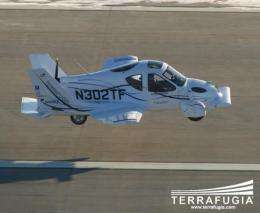The Terrafugia Transition is a roadable aircraft that was tested last year. DARPA's plans for the Transformer X call for the vehicle to be capable of flying on autopilot and driving off-road, among other features. Credit: Terrafugia.
(PhysOrg.com) -- Last week, DARPA announced that it is inviting proposals to tackle its latest project: "a vertical takeoff and landing roadable air vehicle." The ground-to-sky vehicle, called Transformer X (TX), should have a maximum payload capacity of 1,000 pounds so that it can carry four passengers and their gear. It should also be capable of flying itself automatically, achieving an altitude of 1,000 feet, and traveling 250 miles on a single tank of fuel. And it should be built and ready for testing by 2015.
To date, as an article at The Register notes, the closest thing to a flying car that has been built and tested is the Terrafugia Transition. With the press of a button, the wings on this “roadable aircraft” can be folded up in 30 seconds, enabling it to switch from flying to driving on roads. But the proposed TX would have some significant differences, such that it would be a robust off-road vehicle with road performance similar to an SUV, and that it would have the option to fly on autopilot.
The robustness and ease of operation would be essential for various military missions that DARPA has in mind for the TX. For instance, this “sky jeep” could fly over the minefields and roadside bombs that typically surround US bases in Afghanistan or other war territories, and then land to carry out a ground patrol, which requires stopping to set up checkpoints and other ground-based tasks. The TX could also be used to stealthily carry supplies or passengers between ships at sea and a mainland area.
DARPA’s plans require that the TX be no larger than 30 feet long, 8.5 feet wide, and 9 feet high in ground configuration (about the size of two Hummers). The TX should lift off the ground without forward motion, and then climb upward at least one foot for every six feet forward. DARPA also specifies that the TX should be as quiet as a conventional automobile in ground mode and make no more noise than a single engine helicopter when flying, while achieving similar speeds.
The final major advantage of the TX would be that, since its robotic autopilot mode makes it capable of completely unmanned flight, it wouldn’t require extensive training to operate. Currently, every Marine aircraft is piloted by a trained pilot, as The Register notes. With the TX, passengers could operate the vehicle simply by selecting a destination or typing in some coordinates. However, the vehicle would still have an operating range between fully autonomous to allowing a human operator to make flight steering commands in real time.
DARPA wants a prototype that will be ready for ground and flight tests by 2015, and that will cost no more than $43 million to develop. Although the TX is currently just a lofty goal, it has the potential to transform military transportation - and possibly even civilian transportation, if everything goes as planned.
More information:
DARPA TX Announcement [pdf]
via: The Register
© 2010 PhysOrg.com




















